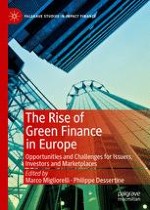This book offers a comprehensive discussion of how green finance has been growing thus far and explores the opportunities and key developments ahead, with particular emphasis on Europe. The main features of the market, the key products, the issue of correctly defining green finance, the main policy actions undertaken, the risk of green washing and the necessary steps to mainstream green finance are discussed in depth. In addition, the book analyses some highly relevant aspects of the market that so far have not been sufficiently explored in the policy, industry and academic debate. This includes the potential role of digitalisation and blockchain in fostering green finance, the crucial role of the effective financing of the agriculture to reach climate and environmental targets and the possible relationship between sustainable finance and other forms of "alternative" finance. This book will be of interest to academics, practitioners, financial institutions and policy makers involved in green finance and to the finance industry in general.
